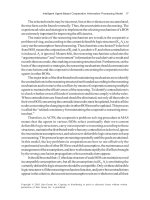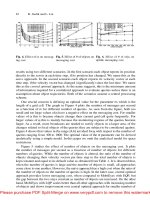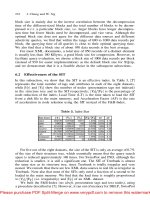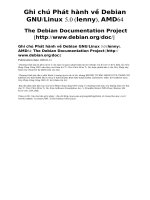Project plan odessa mobile technology project doc
Bạn đang xem bản rút gọn của tài liệu. Xem và tải ngay bản đầy đủ của tài liệu tại đây (141.21 KB, 22 trang )
ODESSA MOBILE TECHNOLOGY PROJECT
Project Plan
Odessa Mobile
Technology Project
Author: Debbie Whitson
Creation Date: 7/10/03
Last Revised: 7/10/03
Version: 1.0
ODESSA MOBILE TECHNOLOGY PROJECT
TABLE OF CONTENTS
INTRODUCTION 3
PURPOSE OF PLAN 3
BACKGROUND INFORMATION/AVAILABLE ALTERNATIVES 3
PROJECT APPROACH 4
PHASE X: SECURE EQUIPMENT 4
GOALS AND OBJECTIVES 5
BUSINESS GOALS AND OBJECTIVES 5
PROJECT GOALS AND OBJECTIVES 5
SCOPE 6
SCOPE DEFINITION 6
ITEMS BEYOND SCOPE 7
PROJECTED BUDGET 7
RISK ASSESSMENT 8
INITIAL PROJECT RISK ASSESSMENT 9
MILESTONES 12
ASSUMPTIONS 13
PROJECT ASSUMPTIONS 13
CONSTRAINTS 14
PROJECT CONSTRAINTS 14
RELATED PROJECTS 14
CRITICAL PROJECT BARRIERS 14
PROJECT MANAGEMENT APPROACH 15
PROJECT TIMELINE 15
PROJECT ROLES AND RESPONSIBILITIES 15
ISSUE MANAGEMENT 17
COMMUNICATIONS PLAN 18
ATTACHMENTS/APPENDICES 20
APPROVALS 21
SIGN-OFF SHEET 21
2
INTRODUCTION
Purpose of Plan
The Odessa Mobile Technology Project Plan will provide a definition of the
project, including the project’s goals and objectives. Additionally, the Plan will
serve as an agreement between the following parties: Project Sponsor, Steering
Committee, Project Manager, Project Team, and other personnel associated with
and/or affected by the project.
The Project Plan defines the following:
− Project purpose
− Business and project goals and objectives
− Scope and expectations
− Roles and responsibilities
− Assumptions and constraints
− Project management approach
− Ground rules for the project
− Project budget
− Project timeline
− The conceptual design of new technology
Background Information/Available Alternatives
Debbie: This section should describe the work you have done to date, the
choices you had with regard to hardware/software, and an explanation of how
you arrived at the decision to use L3 and Tiburon.
3
Project Approach
This section should outline the way you will roll out the technology, including the
highest level milestones.
For example:
Phase I: Secure agreement with vendors (L3 and Tiburon)
Phase II: Order/Install Equipment
Phase III: Install/Test Software
Phase IV: Conduct Hardware/Software Testing
Phase V: Conduct Training
Phase VI: Implement ARS/AFR
Phase X: Secure Equipment
Define the phases in more detail.
4
GOALS AND OBJECTIVES
Business Goals and Objectives
The business goals and objectives for this project will focus on implementing
mobile technology that:
− Improves officer, firefighter and citizen safety.
− Facilitates coordination and information sharing both internal and external to
the participating organizations.
− Enhances the ability and effectiveness of staff to perform their jobs.
− Facilitates coordinated crime prevention and reduction.
− Provides high levels of data security.
− Provides an open, flexible, reliable technology base for the future.
− Facilitates the electronic capture of data at its source.
− Is easy to use.
− Eliminate redundant data entry throughout the organization.
Project Goals and Objectives
Sample project goals and objectives:
− Ensure that end users have input into the design process.
− Accomplish project business goals and objectives within defined budget and
time parameters.
− Minimize impact to standard business operations within the affected units.
− Craft a favorable and secure agreement between the Department and the
selected vendor.
5
SCOPE
Scope Definition
The Project will introduce new mobile technology; including the following:
− 35 mobile devices
− Digital CAD dispatch software
− Car to car messaging
− Internet access (?)
− Automated field reporting software
− GPS/AVL for automated dispatch
Including the following interfaces:
− CAD
− RMS
− AFR
− TLETS/NCIC/NLETS
Desired Enhancements
− Any?
6
Items Beyond Scope
The project does not include the following:
− Devices in supervisor vehicles
− Desktop hardware upgrade or replacement
− Printers
Projected Budget
Define the project budget and insert it here:
7
Risk Assessment
The initial Risk Assessment (following page) attempts to identify, characterize,
prioritize and document a mitigation approach relative to those risks which can
be identified prior to the start of the project.
The Risk Assessment will be continuously monitored and updated throughout
the life of the project, with monthly assessments included in the status report
(see Communications Plan) and open to amendment by the Project Manager.
Because mitigation approaches must be agreed upon by project leadership
(based on the assessed impact of the risk, the project’s ability to accept the risk,
and the feasibility of mitigating the risk), it is necessary to allocate time into each
Steering Committee meeting, dedicated to identifying new risks and discussing
mitigation strategies.
The Project Manager will convey amendments and recommended contingencies
to the Steering Committee monthly, or more frequently, as conditions may
warrant.
8
Initial Project Risk Assessment
Risk Risk Level
L/M/H
Likelihood
of Event
Mitigation Strategy
Project Size
Person Hours H: Over 20,000
Certainty
Assigned Project Manager,
engaged consultant,
comprehensive project
management approach and
communications plan
Estimated Project
Schedule
H: Over 12 months
Certainty
Created comprehensive project
timeline with frequent baseline
reviews
Team Size at Peak H: Over 15 members
Certainty
Comprehensive communications
plan, frequent meetings, tight
project management oversight
Number of Interfaces to
Existing Systems Affected
H: Over 3
Certainty
Develop interface control
document immediately
Project Definition
Narrow Knowledge Level
of Users
M: Knowledgeable of
user area only
Likely
Assigned Project Manager(s) to
assess global implications
Available documentation
clouds establishment of
baseline
M: More than 75%
complete/current
Likely
Balance of information to be
gathered by consultant
Project Scope Creep L: Scope generally
defined, subject to
revision
Unlikely
Scope intially defined in project
plan, reviewed monthly by three
groups (Project Manager and
Steering Committee) to prevent
undetected scope creep
Consultant Project
Deliverables unclear
L: Well defined
Unlikely
Included in project plan, subject
to amendment
Vendor Project
Deliverables
M: Estimated, not
clearly defined
Somewhat
likely
Included in project plan, subject
to amendment
Cost Estimates Unrealistic L: Thoroughly
predicted by industry
experts using proven
practices to 15%
margin of error
Unlikely
Included in project plan, subject
to amendment as new details
regarding project scope are
revealed
Timeline Estimates
Unrealistic
M: Timeline assumes
no derailment
Somewhat
likely
Timeline reviewed monthly by
three groups (Project Manager
and Steering Committee) to
prevent undetected timeline
departures
Number of Team Members
Unknowledgeable of
Business
L: Team well versed in
business operations
impacted by
technology
Unlikely
Project Manager and consultant
to identify knowledge gaps and
provide training, as necessary
Project Leadership
Steering Committee
existence
L: Identified and
enthusiastic
Unlikely
Frequently seek feedback to
ensure continued support
9
Risk Risk Level
L/M/H
Likelihood
of Event
Mitigation Strategy
Absence of Commitment
Level/Attitude of
Management
L: Understands value &
supports project
Unlikely
Frequently seek feedback to
ensure continued support
Absence of Commitment
Level/Attitude of Users
L: Understands value &
supports project
Unlikely
Frequently seek feedback to
ensure continued support
Absence of Mid-
Management Commitment
L: Most understand
value & support project
Unlikely
Frequently seek feedback to
ensure continued support
Project Staffing
Project Team Availability M: Distributed team
makes availability
questionable
Somewhat
likely
Continuous review of project
momentum by all levels.
Consultant to identify any impacts
caused by unavailability. If
necessary, increase
committmment by participants to
full time status
Physical Location of Team
prevents effective
management
M: Team is dispersed
among several sites
Likely
Use of Intranet project website,
comprehensive Communications
Plan
Project Team’s Shared
Work Experience creates
poor working relationship
M: Some have worked
together before
Somewhat
likely
Comprehensive Communications
Plan
Weak User Participation
on Project Team
L: Users are part-time
team members
Unlikely
User Group Participants
coordinated by full time employee
Project Management
Procurement
Methodology Used foreign
to team
L: Procurement
Methodology familiar to
team
Unlikely
N/A
Change Management
Procedures undefined
L: Well-defined
Unlikely
N/A
Quality Management
Procedures unclear
L: Well-defined and
accepted
Unlikely
N/A
Software Vendor
Number of Times Team
Has Done Prior Work with
Vendor Creates Foreign
Relationship
H: Never
Certainty
A comprehensive vendor
evaluation and selection process
(incorporated into Project Plan)
will be employed to predict and
define the relationship between
the department and the vendor
Team’s Lack of Knowledge
of Package
M: Conceptual
understanding
Somewhat
likely
Comprehensive vendor evaluation
and selection process incorporated
into Project Plan will assist the
team in better understanding the
package offering(s)
10
Risk Risk Level
L/M/H
Likelihood
of Event
Mitigation Strategy
Poor Functional Match of
Package to Initial System
Requirements
L: Minimal
customization required
Unlikely
Although a package has not yet
been selected, the Consultant has
compared the initial requirements
with available functionality and
determined that a functional
match to the initial requirements
is very likely. Vendor selection will
be based, in part, on how well the
proposed application matches
defined functional specifications.
Team’s Involvement in
Package Selection Impacts
Success of
Implementation
L: High involvement in
selection
Unlikely
Comprehensive vendor evaluation
and selection process incorporated
into Project Plan
11
Milestones
The following represent key project milestones, with estimated completion dates:
Milestone Estimated Completion Date
Phase I: XXX
Initial Steering Committee Meeting 00/00/2003
12
ASSUMPTIONS
Project Assumptions
The following assumptions were made in preparing the Project Plan:
− OPD employees are willing to change business operations to take advantage
of the functionality offered by the new mobile technology.
− Management will ensure that project team members are available as needed
to complete project tasks and objectives.
− The Steering Committee will participate in the timely execution of the Project
Plan (i.e., timely approval cycles and meeting when required).
− Failure to identify changes to draft deliverables within the time specified in the
project timeline will result in project delays.
− Project team members will adhere to the Communications Plan.
− Mid and upper management will foster support and “buy-in” of project goals
and objectives.
− The City will ensure the existence of a technological infrastructure that can
support the new mobile technology.
− All project participants will abide by the guidelines identified within this plan.
− The Project Plan may change as new information and issues are revealed.
13
CONSTRAINTS
Project Constraints
The following represent known project constraints:
− Project funding sources are limited, with no contingency.
− Due to the nature of law enforcement, resource availability is inconsistent.
Related Projects
None known.
Critical Project Barriers
Unlike risks, critical project barriers are insurmountable issues that can be
destructive to a project’s initiative. In this project, the following are possible
critical barriers:
− Removal of project funding
− Natural disasters or acts of war
Should any of these events occur, the Project Plan would become invalid.
14
PROJECT MANAGEMENT APPROACH
Project Timeline
Insert here
Project Roles and Responsibilities
Role Responsibilities Participant(s)
Project
Sponsor
Ultimate decision-maker and tie-breaker
Provide project oversight and guidance
Review/approve some project elements
Insert Name
Steering
Committee
Commits department resources
Approves major funding and resource
allocation strategies, and significant
changes to funding/resource allocation
Resolves conflicts and issues
Provides direction to the Project Manager
Review project deliverables
Insert Names
Project
Manager
Manages project in accordance to the
project plan
Serves as liaison to the Steering Committee
Receive guidance from Steering Committee
Supervises consultants
Supervise vendor(s)
Provide overall project direction
Direct/lead team members toward project
objectives
Handle problem resolution
Manages the project budget
Debbie Whitson
Project
Participants
Understand the user needs and business
processes of their area
Act as consumer advocate in representing
their area
Communicate project goals, status and
progress throughout the project to personnel
in their area
Review and approve project deliverables
Creates or helps create work products
Coordinates participation of work groups,
individuals and stakeholders
Provide knowledge and recommendations
Helps identify and remove project barriers
Assure quality of products that will meet
the project goals and objectives
Identify risks and issues and help in
resolutions
To be identified by Steering
Committee
15
Role Responsibilities Participant(s)
Subject
Matter
Experts
Lend expertise and guidance as needed To be identified by Steering
Committee
16
Issue Management
The information contained within the Project Plan will likely change as the project
progresses. While change is both certain and required, it is important to note that
any changes to the Project Plan will impact at least one of three critical success
factors: Available Time, Available Resources (Financial, Personnel), or Project
Quality. The decision by which to make modifications to the Project Plan
(including project scope and resources) should be coordinated using the
following process:
Step 1: As soon as a change which impacts project scope, schedule,
staffing or spending is identified, the Project Manager will document
the issue.
Step 2: The Project Manager will review the change and determine the associated
impact to the project and will forward the issue, along with a recommendation,
to the Steering Committee for review and decision.
Step 3: Upon receipt, the Steering Committee should reach a consensus
opinion on whether to approve, reject or modify the request based
upon the information contained within the project website, the Project
Manager’s recommendation and their own judgment. Should the Steering
Committee be unable to reach consensus on the approval or denial of a
change, the issue will be forwarded to the Project Sponsor, with a written
summation of the issue, for ultimate resolution.
Step 4: If required under the decision matrix or due to a lack of consensus, the Project
Sponsor shall review the issue(s) and render a final decision on the approval or
denial of a change.
Step 5: Following an approval or denial (by the Steering Committee or Project
Sponsor), the Project Manager will notify the original requestor of the action
taken. There is no appeal process.
17
Communications Plan
Disseminating knowledge about the project is essential to the project’s success.
Project participants desire knowledge of what the status of the project is and how
they are affected. Furthermore, they are anxious to participate. The more that
people are educated about the progress of the project and how it will help them
in the future, the more they are likely to participate and benefit.
This plan provides a framework for informing, involving, and obtaining buy-in
from all participants throughout the duration of the project.
Audience This communication plan is for the following audiences:
− Project Sponsor
− Steering Committee
− Project Manager
− User Group Participants
− Subject Matter Experts
Communications Methodology The communications methodology utilizes
three directions for effective communication:
Top-Down It is absolutely crucial that all participants in this project sense
the executive support and guidance for this effort. The executive
leadership of the organization needs to speak with a unified, enthusiastic
voice about the project and what it holds for everyone involved. This will
be 'hands-on' change management, if it is to be successful. Not only will
the executives need to speak directly to all levels of the organization, they
will also need to listen directly to all levels of the organization, as well.
The transition from the project management practices of today to the
practices envisioned for tomorrow will be driven by a sure and convinced
leadership focused on a vision and guided by clearly defined, strategic,
measurable goals.
Bottom-Up To ensure the buy-in and confidence of the personnel
involved in bringing the proposed changes to reality, it will be important to
communicate the way in which the solutions were created. If the
perception in the organization is that only the Steering Committee created
the proposed changes, resistance is likely to occur. However, if it is
understood that all participants were consulted, acceptance seems more
promising.
18
Middle-Out Full support at all levels, where the changes will have to be
implemented, is important to sustainable improvement. At this level (as
with all levels), there must be an effort to find and communicate the
specific benefits of the changes. People need a personal stake in the
success of the project management practices.
Communications Outreach The following is a list of communication events that
are established for this project:
Monthly Status Reports The Project Manager shall provide monthly
written status reports to the Steering Committee. The reports shall include
the following information tracked against the Project Plan:
- Summary of tasks completed in previous month
- Summary of tasks scheduled for completion in the next month
- Summary of issue status and resolutions
Monthly Steering Committee Meeting These status meetings are held
at least once per month and are coordinated by the Project Manager.
Every member of the Steering Committee participates in the meeting. The
Project Manager sends the status report to each member of the team prior
to the meeting time so everyone can review it in advance.
Bi-Monthly Project Team Status Meeting These status meetings are
held every other month. Every member of the Project Team will be invited
to participate in the meeting. Project Manager sends the status report to
each member of the team prior to the meeting so everyone can review it in
advance.
Website Use User Group Participants and Subject Matter Experts may be
updated monthly at the discretion of the Project Manager. Information will
be posted to the project’s website.
19
ATTACHMENTS/APPENDICES
Appendices/Attachments may be included in a hardcopy form
20
APPROVALS
Sign-off Sheet
I have read the above Project Plan and will abide by its terms and conditions
and pledge my full commitment and support for the Project Plan.
Project Sponsor:
Date
Project Manager:
Date
Steering Committee:
Date
Steering Committee:
Date
Steering Committee:
Date
Steering Committee:
Date
Steering Committee:
Date
Steering Committee:
Date
Steering Committee:
Date
Steering Committee:
Date
Steering Committee:
Date
Steering Committee:
Date
Steering Committee:
Date
21
Steering Committee:
Date
Steering Committee:
Date
Steering Committee:
Date
Steering Committee:
Date
22









